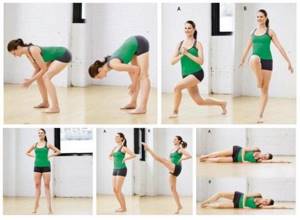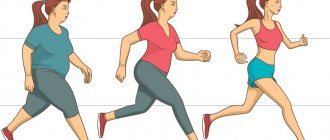The importance of cardio for our health
Blood delivers oxygen molecules throughout the body, to every cell. Without oxygen, a human cell quickly dies. For example, a cerebral stroke is the result of a lack of oxygen for gray matter cells, and a myocardial infarction is the result of a lack of oxygen in the heart muscle.
The main reason for the lack of oxygen in any cells is problems with blood transportation. This problem is created by an inactive lifestyle, sedentary work, obesity and many other factors.
Cardio is the acceleration of the heart and, as a result, more frequent and deeper breathing. The blood becomes saturated with oxygen faster as you begin to inhale air more often and breathe deeper. It moves faster through the body, as the heart rate noticeably accelerates. Conclusion - our body is washed many times better with blood. This is partly why we experience a certain euphoria after training.
So, you've found out why cardio is so good for the body. Now let's find out how to do cardio at home.
Despite the fact that the title of the article implies cardio for every day, you can do it 2-5 times a week, it all depends on your capabilities and desire. Remember, if you do this at least twice a week, even at home, you are already healthier and stronger than those who do not do this at all!
How to do cardio to lose weight?
Under ideal conditions, it is better to do aerobic exercise after strength training (70-80% of 1 RM for 10-12 repetitions 4-5 approaches per muscle group in one training session, work out 2-3 groups, perform 2-3 exercises per group) , which will allow you to completely get rid of glycogen stores. After which you can start using an exercise bike, treadmill or rowing machine at 55-75% heart rate for 40 to 60 minutes.
If it is not possible to pre-strength load, you can do a 60-90 minute aerobic session in the same heart rate range. The advantages of doing cardio for weight loss include low tension in the joint-ligamentous system, low requirements for the power of the cardiovascular system, which allows you to further prepare the body for work with high intensity.
Preparing the room for cardio exercise
Since we decided to exercise at home, we will talk specifically about indoor training. The main condition for any cardio is a good microclimate in the room. If you work out on the street, then everything is easier. And if at home, you need to prepare.
First, do a wet cleaning, clean all carpets, and wipe off dust from surfaces. It is necessary that the room is clean so that during training dust and dirt that has risen from long-forgotten places of their accumulation do not enter your lungs.
Then ventilate the room well, it is best to use an air conditioner and a humidifier. On the one hand, you can open the window, but here the risk of getting sick increases significantly. If you are a fairly seasoned person, or it’s warm outside, open the window: let access to fresh air be open. If not, ventilate the room well before training.
All these preparations in themselves will be a good workout, right?
Preparing your body for cardio training
The main points are as follows:
- cloth;
- nutrition;
- well-being.
Let's look at them in order.
Cloth
Since you are in privacy, you can wear any comfortable clothes. The main thing is that they “breathe”. You can practice in your underwear if no one really sees you. And be prepared that your clothes will get wet after training, and you will need to take a shower.

Nutrition
With nutrition, everything is simple - you need to exercise at least an hour after eating. And the larger the meal, the more time is needed. Sometimes an hour won't be enough - go by how you feel.
If nothing gurgles in your stomach when jumping, you can start training. Eating as much as you want before training is not the best thing. It’s better to have a snack, and you can eat the rest half an hour after exercise.
Well-being
If you feel completely fine, start training. But if you have a headache, something aches, severe shortness of breath, etc., you should wait. If you suffer from high blood pressure, have your blood pressure measured before exercise. Do you have a blood pressure monitor at home? If not, you need to buy it.
If you have any heart problems, you need to exercise carefully and try not to overload your “perpetual motion machine.” That is, you need to navigate according to your feelings. If everything goes well, practice. If you feel discomfort, you need to reduce the load.
We strictly do not recommend exercising at elevated body temperatures. The heart is already accelerated, it’s hard for the body. Cardio in this state can be harmful.
In any sport you need to train at least three times a week. Amateur athletes can afford to train five times a week.
The World Health Organization (WHO) standard is 90 to 150 minutes of cardio training per week.
If you are a beginner and your cardio workout lasts 30 minutes, then the minimum requirement for you is three workouts per week for 30 minutes - 90 minutes per week.
If you are a beginner who is full of enthusiasm and willpower, then you can afford five cardio workouts per week for 30 minutes - 150 minutes per week.
You shouldn’t start with three workouts a week for 50 minutes. In training, as in fractional feeding for babies, it is better to eat often and in small portions.
If you start with three workouts a week, then it is better to call one workout “long” and gradually increase the time in it. Fat-burning cardio workouts are about time, not speed.
For example, in the first week you did three workouts of 30 minutes, and in the second two workouts of thirty minutes, and the third - 33 minutes. So, by increasing 3-5 minutes per week in a long workout over 4-6 weeks, you can increase its time to 50 minutes. And if in the first week your cardio training plan was three workouts of 30 minutes, then in the sixth week two of 30 minutes and one of 50 minutes.
When planning your week of training, always keep your annual training plan in mind. For beginners, it is normal to increase the load by 3% per week. With such an increase in load over the year, your workouts will increase by 2.5 times. This is very big progress! And in our example, 3% is just 3 minutes of cardio training once a week. Once you've built up your long workout to 50 minutes per week, you can start building up all of your workouts to 3-5 minutes, so that your long workout is always longer than your other cardio workouts in the week.
Increasing your training load by 3 minutes per week is a right, not an obligation. If you feel that your body is not ready to increase the load, then it is better to tighten up and train without increasing the load.
Simple conclusions:
— do cardio training at least three and no more than five times a week; — start with three workouts a week for 30 minutes; - increase the load by 3 minutes per week in a long workout; - when the long workout has become 50 minutes, then you can increase all regular workouts by 3 minutes per week, and the long workout by 5 minutes, following the 10% rule.
If you want to get yourself in order and need help, then write to me on , or Instagram
Lev Goncharov - fitness trainer
[media=https://www.instagram.com/p/BuVXCQfFkh4/]
Cardio Options at Home
Doing cardio at home is very easy. There are many options, and some of them do not require financial investment.
Jump rope
We think each of you is able to buy a jump rope. Yes, this is also cardio, and a good one at that. This is how boxers and “Thais” warm up before training. They usually warm up with 3 rounds of jumping jacks with a one minute break in between. All you have to do is start from one minute. Time yourself!
Choose the pace of your jumps yourself. If you don’t know how to jump and have never tried, first jump without a rope. Imitate working with it. Jump on your toes without letting your heels touch the floor.
You can jump rope every day. The first workout will take 1 minute. The next day, you can gradually increase the time to 2 minutes. For example: second day – 70 seconds. The third - 80 and so on until 120 seconds. There should be a break of 30–60 seconds between two-minute jumps.
For trained people, you can immediately jump for 2 or more minutes without stopping.
3 times for 2 minutes together with breaks will total 9 minutes, this is enough for cardio. You will work up a good sweat and your heart will beat at a rate of 120 beats per minute. It's minimum.
Trained people can jump as much as they want.
Running in place
“Running in place is generally reconciling,” as Vysotsky sang, is not the best option for cardio, but it’s better than nothing. It comes down to alternately raising the knees without shifting the body relative to the floor. Like jumping rope, for neighbors below, running in place is accompanied by incredible stomping.
At home, running in place can be continued for 5–10 minutes daily or 4–5 times a week. In general, do it as much as necessary.
When running, you should hold your hands as if you were really running. This will help increase the effect of the exercise. Hand movements help to breathe deeper and promote at least some work of the muscles of the upper body.
This is a harmless exercise, so you can do it for as long as you like. And in terms of frequency of classes per week – at least every day. Focus on how you feel, but don’t be lazy.
Exercise sets
A good thing is a strength complex, during which several exercises are done without stopping. After this, a short break is arranged and everything is repeated again. This is an excellent way to exercise your muscles and heart.
For example:
- Push-ups from the floor – 10 times.
- Jump squats – 10 times.
- Press fold – 10 times.
- Plank – 30 seconds.
- We rest for 30 seconds.
You need to repeat 3 times. The number of repetitions here is small, so this load option is suitable for people with an initial level of training.
If a person is heavy or overweight, you can limit yourself to regular squats. No need to jump out.
This exercise option for the heart can be done 3-4 times a week or daily. Gradually increase the number of repetitions. How many times is an individual matter. Focus on the principle of “do no harm.” That is, you need to speed up your heart, but also so that it doesn’t get worse.
Dancing and aerobics
Find a good aerobics program on YouTube. Display the image on the big screen and stand in front of it. Just do everything they say. Repeat after the instructor.
Aerobics is a great way to spend 30-45 minutes of your free time usefully. You will receive a charge of vivacity, energy, and mood. And how many good emotions you will get! Everything is done to the music, a positive charge is guaranteed.
Cardio equipment at home
You can place any of these exercise machines in the corner of the room and exercise several times a week or every day:
- ellipsoid;
- exercise bike;
- stepper;
- treadmill.
Decide for yourself how many classes you need. Minimum – 2 times a week.
What are the benefits of such simulators? They imply different complex operating modes. That is, you can put a variable load, you can leave it constant. Modern exercise machines have a system for tracking your heart rate, which is very good. You will always know how many times per minute your heart beats and control its speed.
The main thing is your desire to engage and understanding how important it is for you. Set your priorities correctly. The quality of your life depends on the choices you make today. What do you choose: a can of beer or 10 minutes on the treadmill? You decide.
How much cardio do you need to lose weight?
The best heart rate range for burning fat is 55-75%, that is, if you are 20 years old:
the most effective for you will be 0.55 * (220-20) = 110;
0.75 * (220-20) = 150. That is, the most optimal coverage for you will be 110-150 heart beats per minute,
in this case, the maximum allowable heart rate will be 0.8 * (220-20) = 160 beats per minute.
That is, if the myocardial contraction frequency approaches 160, you must reduce the pace and restore the heart rate to acceptable values, since beyond this threshold you will stop burning fat tissue.










